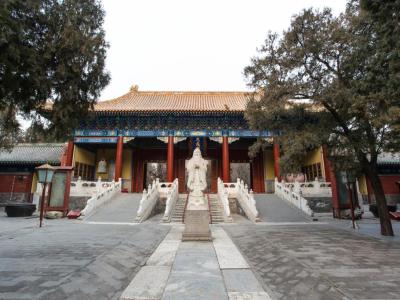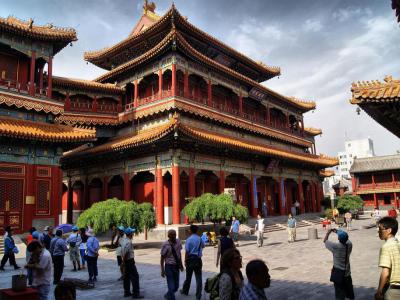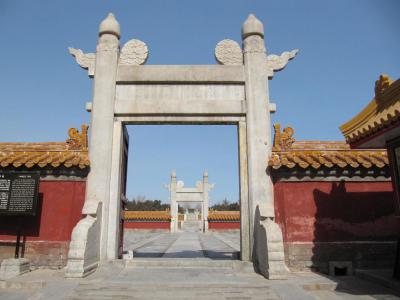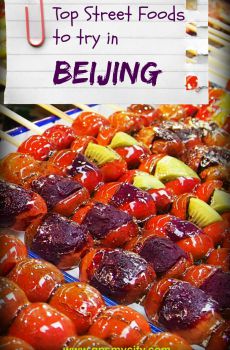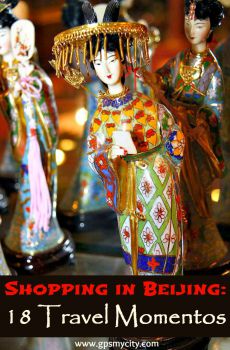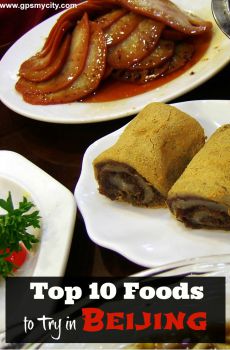
Beijing's Historical Temples Tour I (Self Guided), Beijing
Chinese temples are of unique beauty and have withstood many dynasties. However because the temples have always been connected to the imperial families, many of them were destroyed when the last dynasty ended in 1911. Nevertheless, a great number of beautiful temples with great history still stand in Beijing. Take this self-guided walking tour to discover a few famous temples in the northern part of city.
How it works: Download the app "GPSmyCity: Walks in 1K+ Cities" from Apple App Store or Google Play Store to your mobile phone or tablet. The app turns your mobile device into a personal tour guide and its built-in GPS navigation functions guide you from one tour stop to next. The app works offline, so no data plan is needed when traveling abroad.
Beijing's Historical Temples Tour I Map
Guide Name: Beijing's Historical Temples Tour I
Guide Location: China » Beijing (See other walking tours in Beijing)
Guide Type: Self-guided Walking Tour (Sightseeing)
# of Attractions: 3
Tour Duration: 1 Hour(s)
Travel Distance: 0.9 Km or 0.6 Miles
Author: nataly
Sight(s) Featured in This Guide:
Guide Location: China » Beijing (See other walking tours in Beijing)
Guide Type: Self-guided Walking Tour (Sightseeing)
# of Attractions: 3
Tour Duration: 1 Hour(s)
Travel Distance: 0.9 Km or 0.6 Miles
Author: nataly
Sight(s) Featured in This Guide:
- Temple of Confucius
- Yonghe / Lama Temple
- Temple of Earth
1) Temple of Confucius (must see)
The Temple of Confucius was constructed in 1302 and later expanded to occupy 20,000 square meters. Today it holds the distinction of being the second largest in China. It is located close to the Imperial Academy on Guozijian Street.
As you enter the temple’s complex, you will find four courtyards that are aligned along the central axis. Some of the prominent structures that extend from south to north of the temple include the Dacheng Gate, Xianshi Gate, Chongshengci and the Dacheng Hall.
On each side of the front courtyard, you will find positioned 198 stone tablets with an inscription of names of Jinshi or advanced scholars from the Qing, Ming and Yuan dynasties. Ancient Chinese historical documents can be found at the Qing and Ming dynasty’s 14 stele pavilions made of stone.
Don't miss out on the drums made of carved stone. These drums were made during the Qianlong period between 1736 and 1795. In the Hall of Great Perfection, you will find an ancient Chinese musical instruments collection. Confucius’ shrine is also in this hall.
The temple ground features a variety of attractive carvings. Pay a visit to this beautiful and interesting temple on your trip to Beijing.
Tip:
The temple's gift shop has gorgeous paper cuttings and prints that you're less likely to find elsewhere. You can combine this visit with the Yonghe Temple, as they are less than 100 meters from each other. Also in front, you have the beautiful Dadu Museum of Art.
As you enter the temple’s complex, you will find four courtyards that are aligned along the central axis. Some of the prominent structures that extend from south to north of the temple include the Dacheng Gate, Xianshi Gate, Chongshengci and the Dacheng Hall.
On each side of the front courtyard, you will find positioned 198 stone tablets with an inscription of names of Jinshi or advanced scholars from the Qing, Ming and Yuan dynasties. Ancient Chinese historical documents can be found at the Qing and Ming dynasty’s 14 stele pavilions made of stone.
Don't miss out on the drums made of carved stone. These drums were made during the Qianlong period between 1736 and 1795. In the Hall of Great Perfection, you will find an ancient Chinese musical instruments collection. Confucius’ shrine is also in this hall.
The temple ground features a variety of attractive carvings. Pay a visit to this beautiful and interesting temple on your trip to Beijing.
Tip:
The temple's gift shop has gorgeous paper cuttings and prints that you're less likely to find elsewhere. You can combine this visit with the Yonghe Temple, as they are less than 100 meters from each other. Also in front, you have the beautiful Dadu Museum of Art.
2) Yonghe / Lama Temple (must see)
Located in the north east part of Beijing city, Yonghe Temple is popularly known as the Lama Temple. This monastery and temple attached to Tibetan Buddhism’s Geluk School is one of the most important and largest Tibetan Buddhist monasteries and is constructed in Tibetan and Han Chinese style.
Construction of this temple started during the Qing Dynasty in 1694 and originally the building was used as the residence of court eunuchs. Later on, it was converted to Prince Yong’s court. He was the son of Kangxi Emperor and the future Yongzheng Emperor. When he ascended the throne in 1722, Yongzheng converted half of the building into a monastery for the Tibetan Buddhism monks while retaining the other half as the imperial palace. This temple houses his coffin since 1735 when he died.
Qianlong Emperor, his successor, elevated the temple to the imperial status by symbolically changing the turquoise tiles to yellow tiles, usually reserved for emperors. Monks from Tibet and Mongolia started using this monastery as their residence and ever since this Lamasery has grown to be the national center of Lama Administration.
Yonghe Temple has successfully survived the Cultural Revolution of the 1960s-70s, largely due to the protection of Zhou Enlai, then Prime Minister of China. In 1981, the temple was reopened to the public. Today it attracts tourists from all parts of the world.
Why You Should Visit:
The temple is quite beautiful in itself and the largest Buddha carved from a single piece of wood is a major highlight here.
Tip:
Upon entering, you can receive free incense to burn on site or take home as a nice memento. Across the street from the subway exit, there's a tea shop that also sells ice cream, very popular with locals!
Construction of this temple started during the Qing Dynasty in 1694 and originally the building was used as the residence of court eunuchs. Later on, it was converted to Prince Yong’s court. He was the son of Kangxi Emperor and the future Yongzheng Emperor. When he ascended the throne in 1722, Yongzheng converted half of the building into a monastery for the Tibetan Buddhism monks while retaining the other half as the imperial palace. This temple houses his coffin since 1735 when he died.
Qianlong Emperor, his successor, elevated the temple to the imperial status by symbolically changing the turquoise tiles to yellow tiles, usually reserved for emperors. Monks from Tibet and Mongolia started using this monastery as their residence and ever since this Lamasery has grown to be the national center of Lama Administration.
Yonghe Temple has successfully survived the Cultural Revolution of the 1960s-70s, largely due to the protection of Zhou Enlai, then Prime Minister of China. In 1981, the temple was reopened to the public. Today it attracts tourists from all parts of the world.
Why You Should Visit:
The temple is quite beautiful in itself and the largest Buddha carved from a single piece of wood is a major highlight here.
Tip:
Upon entering, you can receive free incense to burn on site or take home as a nice memento. Across the street from the subway exit, there's a tea shop that also sells ice cream, very popular with locals!
3) Temple of Earth
Just outside the second ring road in Beijing, around the Andingmen area, you can find the Temple of Earth. This temple is spread over 42.7 acres and is close to the famous Yonghe Temple.
Temple of Earth was built by Emperor Jia Jing of the Ming Dynasty in 1530. Here, annual ritual of offering to the heaven was held during summer solstice and was attended by Qing and Ming dynasty emperors.
As you enter the temple premises, you will find charming tree lined paths and lush gardens. It was restored and renovated over a period of time after being damaged during the Cultural Revolution. The temple is square in shape because it symbolizes the Earth. It is located to the north of Beijing because Chinese believe that north is the direction of Earth.
Circular shaped Temple of Heaven is located to the South of Beijing. This temple symbolizes sky and heaven. To the East and West lie the temples of Sun and Moon respectively. These four temples are believed to interact in a spiritual manner. Temple of Earth has been listed by the Chinese government among the most important monuments to be preserved.
Temple of Earth was built by Emperor Jia Jing of the Ming Dynasty in 1530. Here, annual ritual of offering to the heaven was held during summer solstice and was attended by Qing and Ming dynasty emperors.
As you enter the temple premises, you will find charming tree lined paths and lush gardens. It was restored and renovated over a period of time after being damaged during the Cultural Revolution. The temple is square in shape because it symbolizes the Earth. It is located to the north of Beijing because Chinese believe that north is the direction of Earth.
Circular shaped Temple of Heaven is located to the South of Beijing. This temple symbolizes sky and heaven. To the East and West lie the temples of Sun and Moon respectively. These four temples are believed to interact in a spiritual manner. Temple of Earth has been listed by the Chinese government among the most important monuments to be preserved.
Walking Tours in Beijing, China
Create Your Own Walk in Beijing
Creating your own self-guided walk in Beijing is easy and fun. Choose the city attractions that you want to see and a walk route map will be created just for you. You can even set your hotel as the start point of the walk.
Beijing's Historical Temples Tour II
The places of worship are some of the best links to the city's history. The unique churches, Buddhist and Taoist Temples, and beautiful Muslim Mosques all tell great tales of the history of Beijing. Despite that many of them have been partially or completely destroyed over the years either by wars or by the changes of political power, a good number of them still remain. You can visit a few... view more
Tour Duration: 1 Hour(s)
Travel Distance: 2.1 Km or 1.3 Miles
Tour Duration: 1 Hour(s)
Travel Distance: 2.1 Km or 1.3 Miles
Beijing City Center Walking Tour
A political, cultural, and economic center of China for the past eight centuries, Beijing is the newest of the country's Four Ancient Capitals.
The city boasts the grandest and best preserved imperial palaces, gardens and temples, including seven UNESCO World Heritage sites, such as the Forbidden City, Temple of Heaven, Summer Palace, Ming Tombs, Zhoukoudian, and parts of the Great Wall... view more
Tour Duration: 2 Hour(s)
Travel Distance: 3.7 Km or 2.3 Miles
The city boasts the grandest and best preserved imperial palaces, gardens and temples, including seven UNESCO World Heritage sites, such as the Forbidden City, Temple of Heaven, Summer Palace, Ming Tombs, Zhoukoudian, and parts of the Great Wall... view more
Tour Duration: 2 Hour(s)
Travel Distance: 3.7 Km or 2.3 Miles
Olympic Park Walking Tour
The Olympic Park in Beijing was built for the Olympic and Paralympic Games of 2008. This modern complex represents a contemporary architectural approach as compared to the more traditional buildings that dominate the city. Among its signature items are the iconic Bird's Nest, otherwise known as the main Olympic stadium, and the beautiful Water Cube – the Aquatics Center for water sports.
... view more
Tour Duration: 2 Hour(s)
Travel Distance: 5.6 Km or 3.5 Miles
... view more
Tour Duration: 2 Hour(s)
Travel Distance: 5.6 Km or 3.5 Miles
Useful Travel Guides for Planning Your Trip
Best Street Foods to Try in Beijing
China's passion for food – long in history as The Great Wall of China itself – is clearly manifested in its street food culture. This is particularly noticeable on the streets of Beijing, teeming with numerous vendors and thick with aromas. Whether you're a vegan, vegetarian or a...
Most Popular Desserts and Drinks in Beijing
No meal is complete without a sweet touch and a proper drink to wash it all down. Beijing's food scene is rich and colorful in many ways, and the dessert & drink areas are no exception. Some of the signature Beijing delicacies have gained popularity across Asia over the centuries, whereas...
Shopping in Beijing: 18 Travel Mementos
Today, it is safe to assume that 9 out of 10 souvenirs worldwide (regardless of the country) are made in China, the workshop of the world. But how about shopping for souvenirs in China itself and Beijing, in particular? Presented here are some of the traditional Chinese-made goods, initially...
Top 10 Foods to Try in Beijing
Centuries went by and the regional Chinese, Manchurian, Mongol and Muslim cuisines boiled together to produce what's now known and loved as traditional Beijing cooking. Whenever you're in the Chinese capital, don't leave without tasting at least some of the key local meals or your...
The Most Popular Cities
/ view all
